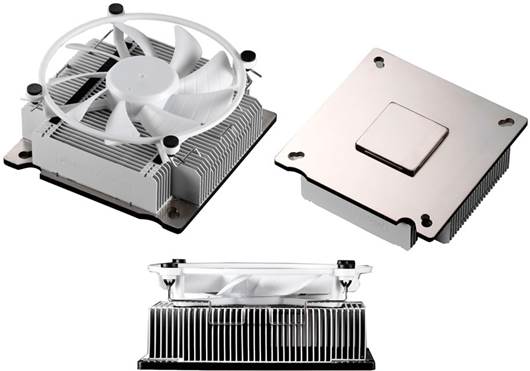ALMOST EVERY CPU cooler we receive nowadays
is some massive tower that loves consuming every square-inch of chassis space.
Because we’ve been inundated with these hulking behemoths, it’s refreshing to
see a Low-profile cooler such as Phanteks’ PH-TC9OLS. At 3.75x3.75x1.77 inches,
this cooler makes the Intel stock cooler look tall and should fit the snuggest
of HTPC builds.
The PH-TC9OLS features a single 9.2cm fan
and nickel-plated aluminum fins on top of a square copper base. Anesthetically,
it’s a no-frills design.

Phanteks
PH-TC90LS
Installing the cooler is, for the most
part, pretty straightforward. The four corners of the PH-TC9OLS have screw
holes that Let you easily mount the cooler onto the MOBO. The fan uses four
rubber pins that allow two mounting clips to attach the fan to the heatsink.
Also included are two adhesive-backed rubber strips to stick between the fan
and heatsink to dampen noise.
We initially had some issues getting enough
mounting tension for the PHTC9OLS when we tried to install it on our LGA2O11
MOBO. It took us three attempts and some major cranking before the Phanteks
cooler would perform as it should. When we tried mounting the PHTC9OLS on our
LGA1155 test bed to see if it was any easier there, the cooler installed
without a hitch using the included backplane. Other than this headache,
installation was relatively painless. Phanteks could have made the process even
easier by having the whole cooler all assembled out-of-the-box Like Intel’s
“stock’ 2011 cooler, the Thermal Solution RTS2O11AC. (We put the word stock in
quotes because 2011 Sandy Bridge-E CPUs don’t actually ship with coolers.)

Also
included are two adhesive-backed rubber strips to stick between the fan and
heatsink to dampen noise.
While we generally test to see how well CPU
coolers perform on our over-clocked Sandy Bridge-E CPU. low-profile coolers
such as the PH-TC9OLS aren’t meant for extreme overclocking. To make
allowances, we reset our thermal-test PC to its stock 3.3GHz clock for our
benchmarks.
Compared to Intel’s RTS2O11AC cooler, the
PH-TC9OLS wasn’t as cool. When both coolers were run in the motherboard’s
Performance mode. Intel’s stock part idled with a 7 degree advantage. The
differential only increased under heavy load. Here, the Phanteks went up to 77 C,
which isn’t bad, but was noticeably warmer than Intel’s cooler by about 13
degrees. However, these temps are stilt perfectly suitable for HTPCs and, more
importantly, the CPU didn’t throttle.
One area where the PH-TC9OLS really
impressed us was in the acoustic department. Those two noise-dampening strips
really did their job. We can’t say the same about Intel’s cooler, which was far
louder under load.
While the PH-TC9OLS isn’t going to win any
thermal awards, its amazingly small form factor makes it a great choice if
you’re looking to build a tiny, quiet HTPC.